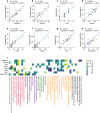Eye movement function captured via an electronic tablet informs on cognition and disease severity in Parkinson's disease
- PMID: 38643273
- PMCID: PMC11032372
- DOI: 10.1038/s41598-024-59750-9
Eye movement function captured via an electronic tablet informs on cognition and disease severity in Parkinson's disease
Abstract
Studying the oculomotor system provides a unique window to assess brain health and function in various clinical populations. Although the use of detailed oculomotor parameters in clinical research has been limited due to the scalability of the required equipment, the development of novel tablet-based technologies has created opportunities for fast, easy, cost-effective, and reliable eye tracking. Oculomotor measures captured via a mobile tablet-based technology have previously been shown to reliably discriminate between Parkinson's Disease (PD) patients and healthy controls. Here we further investigate the use of oculomotor measures from tablet-based eye-tracking to inform on various cognitive abilities and disease severity in PD patients. When combined using partial least square regression, the extracted oculomotor parameters can explain up to 71% of the variance in cognitive test scores (e.g. Trail Making Test). Moreover, using a receiver operating characteristics (ROC) analysis we show that eye-tracking parameters can be used in a support vector classifier to discriminate between individuals with mild PD from those with moderate PD (based on UPDRS cut-off scores) with an accuracy of 90%. Taken together, our findings highlight the potential usefulness of mobile tablet-based technology to rapidly scale eye-tracking use and usefulness in both research and clinical settings by informing on disease stage and cognitive outcomes.
© 2024. The Author(s).
Conflict of interest statement
Author EdV-S is a co-founder of Innodem Neurosciences, which developed the Eye-Tracking Neurological Assessment (ETNA™) technology used in this study. Authors PV and AD-P have ownership options in Innodem Neurosciences. Author NAK is a research intern at Innodem Neurosciences and author JC-F was formerly a part-time employee at Innodem Neurosciences. Author SD has previously served as an advisor to Innodem Neurosciences. The remaining author declares that the research was conducted in the absence of any commercial or financial relationships that could be construed as a potential conflict of interest.
Figures





Similar articles
-
A novel tablet-based software for the acquisition and analysis of gaze and eye movement parameters: a preliminary validation study in Parkinson's disease.Front Neurol. 2023 Jun 15;14:1204733. doi: 10.3389/fneur.2023.1204733. eCollection 2023. Front Neurol. 2023. PMID: 37396780 Free PMC article.
-
Oculomotor analysis to assess brain health: preliminary findings from a longitudinal study of multiple sclerosis using novel tablet-based eye-tracking software.Front Neurol. 2023 Sep 6;14:1243594. doi: 10.3389/fneur.2023.1243594. eCollection 2023. Front Neurol. 2023. PMID: 37745656 Free PMC article.
-
Preservation of Eye Movements in Parkinson's Disease Is Stimulus- and Task-Specific.J Neurosci. 2022 Jan 19;42(3):487-499. doi: 10.1523/JNEUROSCI.1690-21.2021. Epub 2021 Nov 30. J Neurosci. 2022. PMID: 34848498 Free PMC article.
-
Eye Tracking in Parkinson's Disease: A Review of Oculomotor Markers and Clinical Applications.Brain Sci. 2025 Mar 31;15(4):362. doi: 10.3390/brainsci15040362. Brain Sci. 2025. PMID: 40309816 Free PMC article. Review.
-
Eye movements in Parkinson's disease: from neurophysiological mechanisms to diagnostic tools.Trends Neurosci. 2024 Jan;47(1):71-83. doi: 10.1016/j.tins.2023.11.001. Epub 2023 Dec 2. Trends Neurosci. 2024. PMID: 38042680 Review.
Cited by
-
Noradrenergic modulation of saccades in Parkinson's disease.Brain Commun. 2024 Sep 1;6(5):fcae297. doi: 10.1093/braincomms/fcae297. eCollection 2024. Brain Commun. 2024. PMID: 39464213 Free PMC article.
-
Recent advances (2022-2024) in eye-tracking for Parkinson's disease: a promising tool for diagnosing and monitoring symptoms.Front Aging Neurosci. 2025 May 21;17:1534073. doi: 10.3389/fnagi.2025.1534073. eCollection 2025. Front Aging Neurosci. 2025. PMID: 40469846 Free PMC article.
-
Advancements in eye movement measurement technologies for assessing neurodegenerative diseases.Front Digit Health. 2024 Jul 4;6:1423790. doi: 10.3389/fdgth.2024.1423790. eCollection 2024. Front Digit Health. 2024. PMID: 39027628 Free PMC article. Review.
-
Development of Neurodegenerative Disease Diagnosis and Monitoring from Traditional to Digital Biomarkers.Biosensors (Basel). 2025 Feb 11;15(2):102. doi: 10.3390/bios15020102. Biosensors (Basel). 2025. PMID: 39997004 Free PMC article. Review.
References
MeSH terms
Grants and funding
LinkOut - more resources
Full Text Sources
Medical

